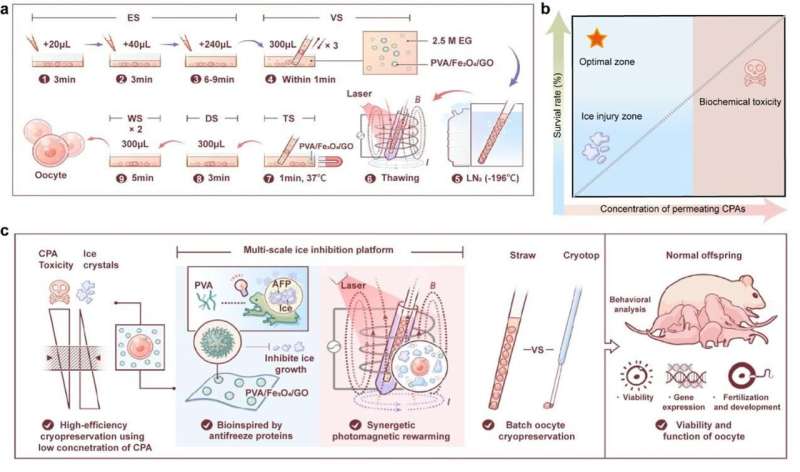Overview of the cryopreservation procedure of oocytes and the schematic diagram of the multi-scale ice inhibition platform . Credit: USTC
Safe and high-quality fertility preservation is of growing significance for women in clinical trials. Current primary methods for cryopreserving human oocytes are slow freezing and vitrification, but existing techniques pose risks of biochemical toxicity and are restricted in large-scale clinical practice.
To solve the issue, research teams developed a multi-scale ice inhibition platform that enables full-cycle cryogenic protection for mouse oocyte. The result was published in Advanced Functional Materials.
The teams were led by Professor Zhao Gang from University of Science and Technology of China (USTC), together with Professor Cao Yunxia from the First Affiliated Hospital of Anhui Medical University (AHMU) and Professor Liu Huanzhong from the Chaohu Hospital Affiliated to Anhui Medical University (AHMU).
The multi-scale ice inhibition platform is based on a nanomaterial, polyvinyl alcohol/Fe3O4/graphene oxide nanoparticles (PFG NPs), offering comprehensive cryogenic protection throughout the entire cycle of oocyte cryopreservation.
Subsequently, by using lower concentrations of cryoprotectants (without DMSO and with extremely low toxicity), researchers achieved high-efficiency and batch cryopreservation of mouse MII oocyte.
The PFG NPs synthesized by researchers have the potential to reduce the degree of supercooling and eliminate the formation of sharp ice crystal morphologies. Additionally, PFG NPs remarkably reduced the IR injury, temperature gradient and devitrification that can harm cell conditions during the rewarming process.
The oocyte preserved by this platform displayed fewer gene variations compared to those using traditional methods, while maintaining their ability for successful offspring birth, demonstrating significant potential in establishing cryobanks dedicated to fertility preservation.
More information: Tie Chang et al, Multi‐Scale Ice Inhibition Platform Enables Full‐Cycle Cryogenic Protection for Mouse Oocyte, Advanced Functional Materials (2024). DOI: 10.1002/adfm.202402312
Journal information: Advanced Functional Materials
Provided by University of Science and Technology of China
























